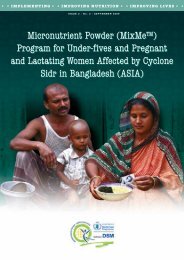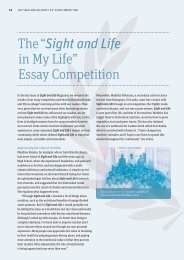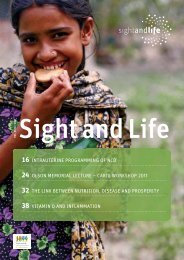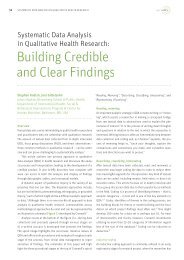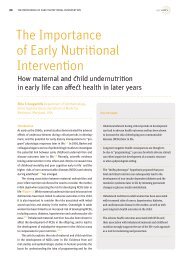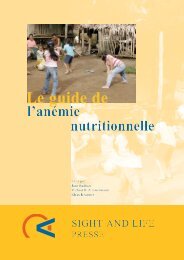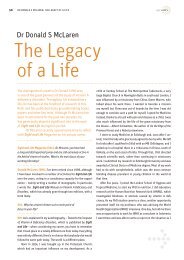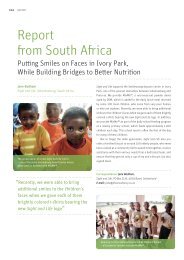Sight and Life Magazine 1/2011
Sight and Life Magazine 1/2011
Sight and Life Magazine 1/2011
You also want an ePaper? Increase the reach of your titles
YUMPU automatically turns print PDFs into web optimized ePapers that Google loves.
12 SIGHT AND LIFE STATEMENTcolonic microflora in African children to create a potentiallymore pathogenic profile. If this is confirmed, it could help to explainthe reported adverse effects of iron supplementation <strong>and</strong>bolus doses of iron.The other potential mechanism discussed is the formationof non-transferrin-bound iron (NTBI). Recently presented dataon the formation of NTBI 8 after administration of iron in womenwith low iron status (NTBI formation monitored over eight hours),showed that the highest NTBI concentrations were produced bya 60 mg dose without food, followed by 60 mg <strong>and</strong> 6 mg withfood. These first data indicate that iron administered with food<strong>and</strong> through fortification (rather than supplementation) resultedin lower NTBI formation.“The two-step approach of optimizingthe MNP formulation for malariaendemic areas is expected to be saferthan typically used iron doses”In conclusion, based on current knowledge, the two-step approachof optimizing the MNP formulation for malaria endemic areasis expected to be safer than typically used iron doses (12.5 mg).The reduction of the iron dose to levels closer to the amount of ironprovided in food fortification helps to reduce the amount of unabsorbediron in the intestine. Meanwhile, using a highly bioavailableiron compound in combination with iron absorption enhancersis crucial to supplying the individual with the iron needed.References01. WHO/WFP/UNICEF Joint Statement. Preventing <strong>and</strong> controllingmicronutrient deficiencies in populations affected by an emergency.Multiple vitamin <strong>and</strong> mineral supplements for pregnant <strong>and</strong>lactating women, <strong>and</strong> for children aged 6 to 59 months. WHO,2007.02. Sazawal, S, Black R, Ramsan M et al. Effects of routine prophylacticsupplementation with iron <strong>and</strong> folic acid on admission to hospital<strong>and</strong> mortality in preschool children in a high malaria transmissionsetting: community-based, r<strong>and</strong>omized, placebo-controlled trial.Lancet 2006;367(9505):133–4303. Oppenheimer SJ. Iron <strong>and</strong> its relation to immunity <strong>and</strong> infectiousdisease. J Nutr 2001;131(2S-2):616S-633S; discussion 633S–635S.04. Ojukwu J, Okebe J, Yahav D et al. Oral iron supplementation forpreventing or treating anemia among children in malaria-endemicareas. Cochrane Database Syst Rev 2009;(3): CD006589.05. WHO. Conclusions <strong>and</strong> recommendations of the WHOConsultation on prevention <strong>and</strong> control of iron deficiency in infants<strong>and</strong> young children in malaria-endemic areas. Food Nutr Bull2007;28:S621–S706. Hurrell, R, Ranum P, de Pee S et al. Revised recommendations foriron fortification of wheat flour <strong>and</strong> an evaluation of the expectedimpact of current national wheat flour fortification programs.Food Nutr Bull 2010;31(1 Suppl):S7–2107. Zimmermann, M, Chassard C, Rohner F et al. The effects of iron fortificationon the gut microbiota in African children: a r<strong>and</strong>omizedcontrolled trial in Côte d'Ivoire. Am J Clin Nutr 2010;92:1406–15.08. Egli I, Brittenham G, Zeder C et al. The influence of supplementation<strong>and</strong> fortification iron doses on the formation of plasma-nontransferrin-boundiron. (UC Davis) Conference on Bioavailability,Asilomar, CA, September 26–30, 2010 (only abstract available)



